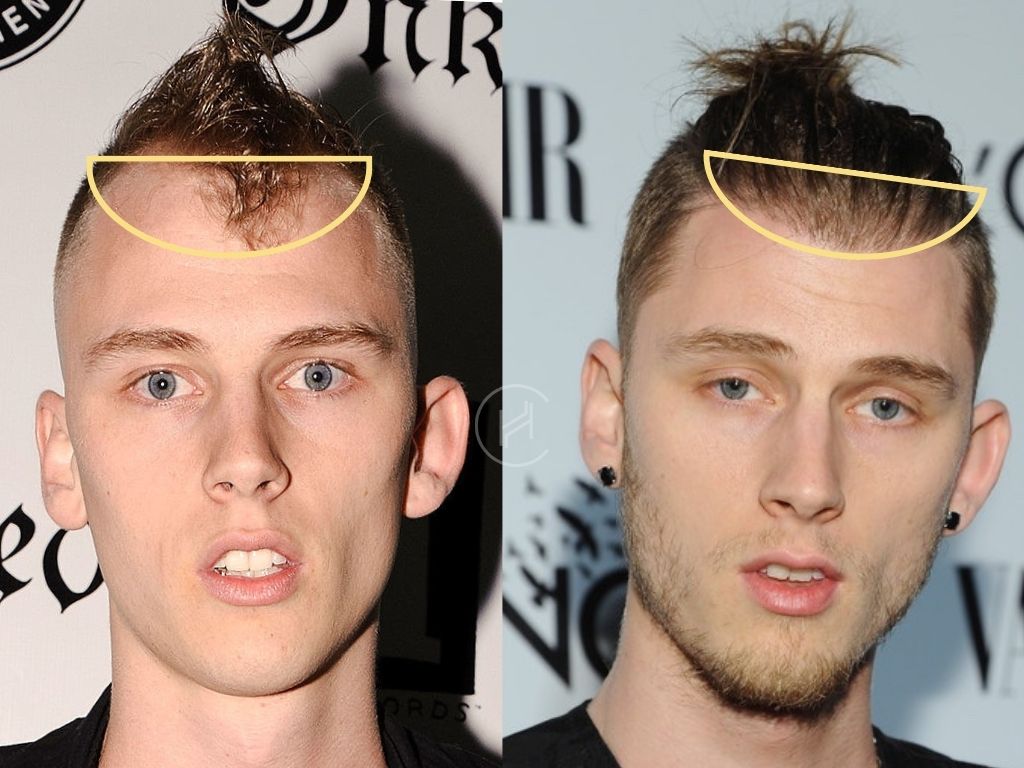Machine Gun Kelly is the latest celebrity to undergo a hair transplant, but what do you need to know about this procedure? In this article, we’ll be exploring the ins and outs of a hair transplant, from how it works and why it may be beneficial for some people, to the potential risks associated with the operation. So read on to find out if getting a hair transplant might be right for you!
Introduction to Machine Gun Kelly’s Hair Transplant
Machine Gun Kelly is an American rapper and actor from Cleveland, Ohio. He first gained popularity as a rapper in the early 2010s after the release of his mixtape “Lace Up”. In recent years, he has also become known for his acting roles in films such as “Nerve” and “The Dirt”.
In February 2020, it was revealed that Machine Gun Kelly had undergone a hair transplant procedure. This news came as a surprise to many fans, as the rapper is only 30 years old. After seeing photos of MGK’s new hairline, it’s clear that the surgery was a success.

There are a lot of questions surrounding MGK’s hair transplant, so we’re here to give you all the information you need to know about it. Keep reading to learn everything from the cost of the procedure to the recovery process.
What Is Machine Gun Kelly Hair Transplant Surgery?
Hair transplant surgery is a procedure in which hair is removed from one area of the scalp and transplanted to another. This can be done to treat baldness or to restore hair that has been lost due to injury or illness.
The most common type of hair transplant surgery is called follicular unit transplantation (FUT). In this procedure, a surgeon removes a strip of skin from the back of the head and dissects it into individual follicular units. Each unit contains one or two hairs. The surgeon then implants the units into tiny incisions made in the balding areas of the scalp.
Another type of hair transplant surgery is called follicular unit extraction (FUE). In this procedure, the surgeon individually removes follicular units from the back of the head with a small punch tool. The units are then transplanted into the balding areas of the scalp.
Hair transplant surgery is usually done under local anesthesia. The procedure takes about four to eight hours, depending on the number of grafts being implanted. Recovery time is typically one to two weeks. There is usually some swelling and bruising around the incisions, but this should resolve within a few weeks.
Most people see significant hair growth within six to nine months after surgery. The final results may not be visible for 12 to 18 months.
Machine Gun Kelly Benefits of a Hair Transplant Surgery
A hair transplant is a medical procedure that removes hair from one area of the scalp and transplants it to another. The two most common types of hair transplants are follicular unit transplantation (FUT) and follicular unit extraction (FUE).
FUT is the traditional hair transplant method. It involves removing a strip of skin from the back of the head, which is then divided into small grafts containing one or two hairs each. These grafts are then implanted into tiny incisions made in the balding areas of the scalp.
FUE is a newer hair transplant method that doesn’t involve removing any skin from the back of the head. Instead, individual hairs are extracted directly from the donor area and transplanted into the balding areas. This method is often considered to be less invasive than FUT because there’s no scarring left behind after surgery.
Both FUT and FUE hair transplant procedures can be used to achieve natural-looking results. And although there’s always a risk of complications with any surgery, serious complications from hair transplants are rare.
Machine Gun Kelly – Steps Involved in the Procedure
In order to fully understand the steps involved in Machine Gun Kelly’s hair transplant, it is important to first understand the basics of how a hair transplant works. A hair transplant is a surgical procedure that involves taking hair from one area of the head (the donor site) and transplanted to another area of the head (the recipient site). The most common type of hair transplant is called follicular unit transplantation (FUT).
During an FUT procedure, a strip of skin containing hair follicles is removed from the donor site. The strip is then divided into small grafts containing one to three hairs each. These grafts are then transplanted to the recipient site.
There are two main types of FUT procedures: follicular unit extraction (FUE) and strip harvesting. With FUE, individual hair follicles are extracted from the donor site and transplanted to the recipient site. With strip harvesting, a strip of skin containing hair follicles is removed from the donor site and then divided into small grafts.
Machine Gun Kelly underwent an FUE procedure. This means that individual hair follicles were extracted from his scalp and then transplanted to his balding areas. The steps involved in an FUE procedure are as follows:
1. Anesthesia is administered to the patient.
2. The donor area is shaved down to stubble.
3. Tiny punches are used to remove individual hair follicles from the donor area.
Machine Gun Kelly Risks and Complications
Hair transplants are a popular cosmetic procedure, but they come with some risks and complications.
The most common complication is infection. This can happen if the hair follicles are not properly disinfected before the transplant, or if bacteria gets into the transplanted area during the surgery. Infection can cause swelling, redness, and pain, and can lead to scarring.
Other risks include:
-Bleeding
-Bruising
-Swelling
-Numbness
-Transplant rejection (the body rejecting the transplanted hair follicles)
Cost of a Machine Gun Kelly Hair Transplant Surgery
Hair transplants are a popular choice for people looking to restore their hairline or cover up balding. The surgery involves taking hair from one area of the head and transplants it to the desired area.
The average cost of a hair transplant surgery is $4,000. However, the price can vary depending on the amount of hair being transplanted, the location of the surgery, and the surgeon performing the procedure.
Some people opt to have multiple sessions of hair transplant surgery to achieve their desired results. It is important to consult with a board certified dermatologist or plastic surgeon to ensure that you are a good candidate for the procedure and to discuss your goals and expected results.
Alternatives to Machine Gun Kelly Hair Transplants
Hair transplants are not the only option for hair loss. There are a number of alternative treatments that can be effective in treating hair loss.
Minoxidil (Rogaine) is a topical medication that is applied to the scalp. It is approved by the FDA for the treatment of pattern baldness in men and women. Minoxidil promotes hair growth by increasing blood flow to the hair follicles. It is available over the counter and does not require a prescription.
Finasteride (Propecia) is a prescription medication that is taken orally. It is approved by the FDA for the treatment of pattern baldness in men. Finasteride works by inhibiting the production of DHT, which is a hormone that contributes to hair loss.
Hairpieces and wigs are another option for those who are experiencing hair loss. There are a variety of wig and hairpiece options available, ranging from human hair wigs to synthetic wigs. Wigs and hairpieces can be worn full-time or part-time, depending on your needs and preferences.
Aftercare for Machine Gun Kelly Hair Transplants
After a hair transplant, it is important to take care of your scalp. This means keeping the area clean and free of any dirt or debris. You will also need to avoid sun exposure and wear a hat or scarf when outdoors. It is also important to avoid strenuous activity or lifting heavy objects for at least two weeks after the procedure.
Conclusion
Machine Gun Kelly’s hair transplant demonstrates that there are options available for those suffering from hair loss. While a hair transplant isn’t suitable for everyone, it can be an effective way to restore your confidence and get the look you want. It’s important to do proper research before making any decisions about getting a hair transplant, so if you’re considering one yourself, make sure to speak with an experienced professional who can provide you with reliable advice and information.


